Skip to content
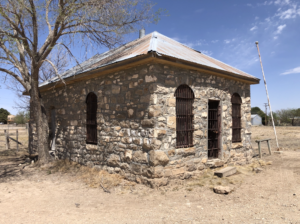
Old, abandoned stone building? (I’m slowing down as I’m driving by.)
Bars on the door and windows? (I’m definitely stopping.)
My first guess that this had to be an old jail turned out to be right on target.
This lonely structure was the Buchel County Jail back when Marathon Texas was the county seat between 1887 and 1897.
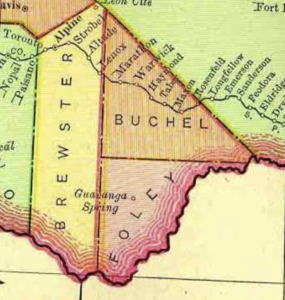 Wait . . . Buchel County? Nope, you’re not losing your marbles. There’s no Buchel County in the Lone Star State! Both Buchel and Foley Counties were absorbed into Brewster County – now the largest county in Texas – when their populations failed to flourish as well as expected.
Wait . . . Buchel County? Nope, you’re not losing your marbles. There’s no Buchel County in the Lone Star State! Both Buchel and Foley Counties were absorbed into Brewster County – now the largest county in Texas – when their populations failed to flourish as well as expected.
There was good reason to want a sturdy jail in town. West Texas was still a pretty wild place filled with cantankerous cowboys and outlaws back then.
But before the town had an actual building for that purpose, a windmill in the middle of North First Street was Marathon’s first jail. Drunks and other petty offenders were chained to one of its legs, and serious offenders were taken down the road to the Alpine jail.
Later, a one-room adobe house behind French’s Store served as a jail but, after several colorful escapes, locals decided that a better “calaboose” was in order, so this rock jailhouse was built.
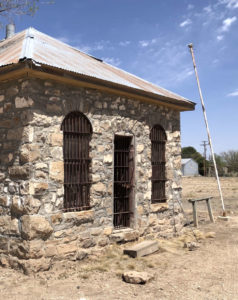
It was constructed just south of the old Ritchey store in town, of rocks dug from a ledge on the northwest side of town. Talk about working with on-hand materials!
I can’t even imagine how hot it was inside this jail during the hot west Texas summer months!
When the Alpine jail was remodeled in 1901, their two old “cages” manufactured by Diebold Safe and Lock were brought to this location and installed. If you peer through the boars on the front door you can easily read the identifying word “L. T. Noyes – Houston, Texas” on the cell locking mechanism on the wall.
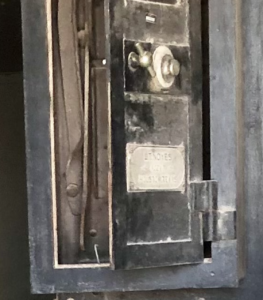 Now this is pretty neat for fans of old-times Texas. Lucius T. Noyes was an agent for the Diebold Safe & Lock Company of Canton, Ohio. From his Houston office on the corner of Congress Avenue and San Jacinto Street he established a far reaching reputation in the world of “security.”
Now this is pretty neat for fans of old-times Texas. Lucius T. Noyes was an agent for the Diebold Safe & Lock Company of Canton, Ohio. From his Houston office on the corner of Congress Avenue and San Jacinto Street he established a far reaching reputation in the world of “security.” 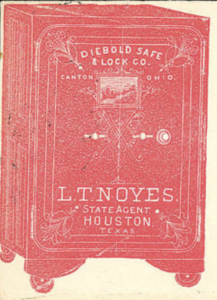
In addition to selling and installing over 50 county vaults and safes in Texas, Louisiana and surrounding states; and countless of the same for banks – he became quite a celebrity as a jail builder.
He sold the steel and iron fittings for the facilities and personally oversaw the construction and contract work for over 100 jails including this one, the impressive 1897 Fort Bend County Jail that now serves as the Richmond Police Department, the 1887 San Jacinto County Jail in Coldspring, the 1894 Glasscock County Jail in Garden City, and the 1886 Live Oak County Jail in Oakville.
I imagine he wasn’t too popular with the bad guys!
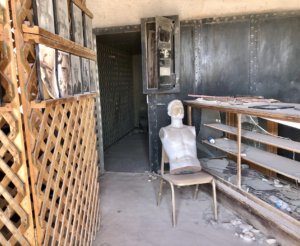 Stealing a peek through the door and windows, it looks like there might have been a museum at Marthon’s little jail at some point, and the decaying remnants are admittedly a bit creepy. That mannequin will definitely take you off guard, but you can clearly see the jail cells, photos of what are probably local lawmen of the past on the wall, and broken display cases – whose contents I can only hope were safely removed before the damage. I’d love to see this “attraction” re-opened for a closer look.
Stealing a peek through the door and windows, it looks like there might have been a museum at Marthon’s little jail at some point, and the decaying remnants are admittedly a bit creepy. That mannequin will definitely take you off guard, but you can clearly see the jail cells, photos of what are probably local lawmen of the past on the wall, and broken display cases – whose contents I can only hope were safely removed before the damage. I’d love to see this “attraction” re-opened for a closer look.
You can find the former Buchel County Jail in Marathon behind the Ritchey Brothers building on South 2nd Street between Avenues C and D.

Ready to peek into Christmas Past, Texas style? Let me take you on a virtual visit to the George Ranch Historical Park in Richmond where they’ve lassoed a wonderful event to share just that!
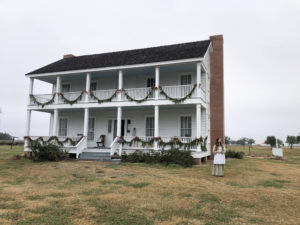
The annual Christmas at the Ranch event was a bit different this year due to additional safety protocols, but the staff couldn’t have created a more welcoming and fascinating day for their guests.
Founded in 1824, the George Ranch showcases the four homes of four generations of this Texas family, and this time of year they’re dressed up for the season.
My first stop was at the visitor center, where I was provided with a map of the ranch and demonstration schedule. The park is laid out in a mile long loop (yes, a MILE), and visitors can ride a tractor pulled tram from one stop to the next. But I highly suggest combining riding and walking when weather permits, to enjoy the natural surroundings.
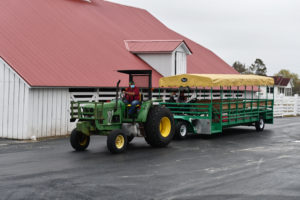
I rode the tram to my first stop, the 1830s Jones Stock Farm dog trot cabin, and was greeted by the volunteers dressed in period costumes. The cabin and buildings are replicas of Henry and Nancy Jones’ homestead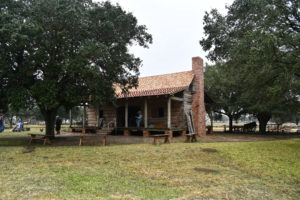 – one of the earliest settlements of Northeast Mexico. Nope, it wasn’t even Texas yet!
– one of the earliest settlements of Northeast Mexico. Nope, it wasn’t even Texas yet!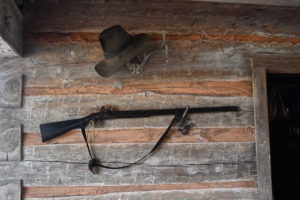
One gentleman shared the background of the family and information about the cabin, and another charmer played beautiful music on his guitar and told a few tall tales that were impossible to resist.
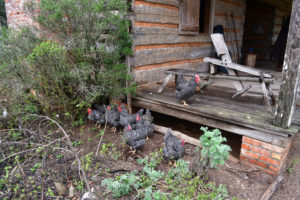
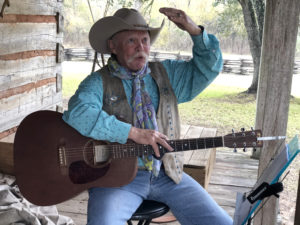
A young woman had the unenviable, sticky task of demonstrating how to clean a deer hide in a yard populated by adorable hens, but managed to do it with a smile while explaining that when the thin hides were worked until thy were translucent, they could be used to cover the cabin windows during the winter months (since glass wouldn’t have been available).
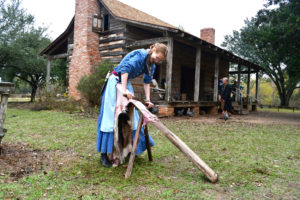
In the breezeway of the dogtrot a young man worked at weaving on a loom, taking breaks to serve visitors Mexican hot cocoa that was brewing over one of the hearth fires – and was a treat on the chilly day.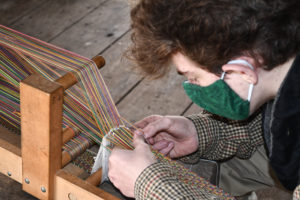
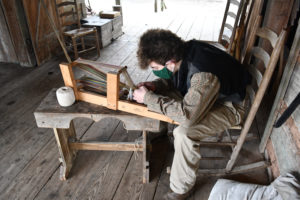
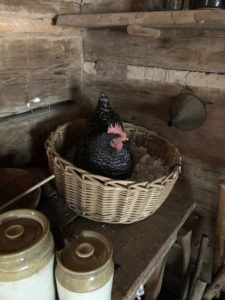
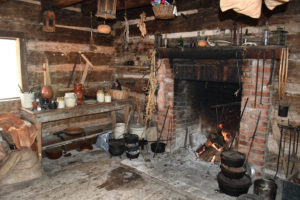
 In the nearby hog pen, one of the volunteers scratched the back of one of the docile 300-pound Berkshire pigs that are part of an initiative to preserve heritage breeds. Seems these fragrant residents are descendants of a rare breed that came to Texas from England in the 1830s. I know people who can’t trace their lineage as well!
In the nearby hog pen, one of the volunteers scratched the back of one of the docile 300-pound Berkshire pigs that are part of an initiative to preserve heritage breeds. Seems these fragrant residents are descendants of a rare breed that came to Texas from England in the 1830s. I know people who can’t trace their lineage as well!
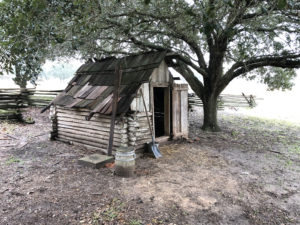 After a quick look at the chicken coop (always interesting to me since gathering the eggs was my job when visiting my grandmother’s farm), smokehouse barn and outdoor kitchen, I worked my way back to the road to hop on the tram again.
After a quick look at the chicken coop (always interesting to me since gathering the eggs was my job when visiting my grandmother’s farm), smokehouse barn and outdoor kitchen, I worked my way back to the road to hop on the tram again.
Next stop: the 1860s Ryon Prairie home – picture perfect with garlands of evergreens draped across the porch rails.
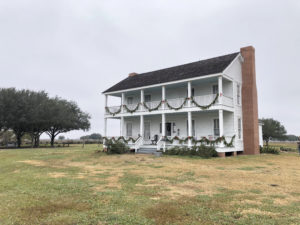
Mary Moore “Polly” Ryon was the oldest of the Jones’ daughters. She inherited th majority of her family’s wealth, and amazingly was on of the largest land holders in the region by age 18! She and her husband William built a cattle ranching empire after the Civil War.
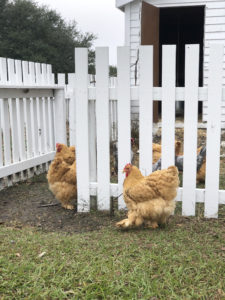
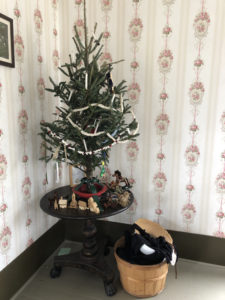 One young woman showed me around the knot garden and chicken coop until it was my turn (social distancing, ya know) to go inside the house.
One young woman showed me around the knot garden and chicken coop until it was my turn (social distancing, ya know) to go inside the house.
Inside two young docents explained the uses of the men’s and women’s parlors, and directed me toward the kitchen where more volunteers were baking cookies for the visitors in a period stove.
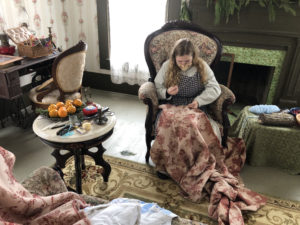
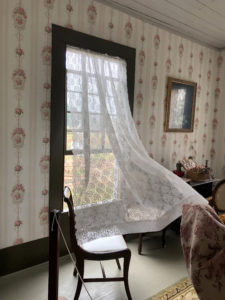
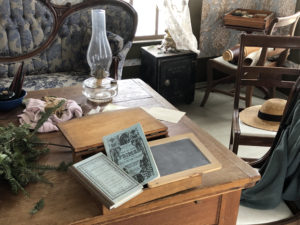
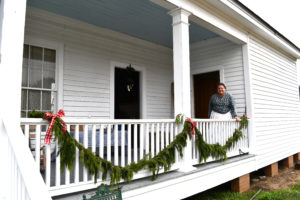
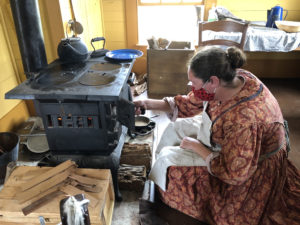
I decided to walk the rest of the property rather than ride the tram since it was a beautiful day and I didn’t see any reason to rush.
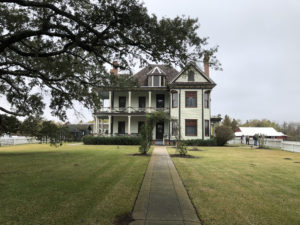
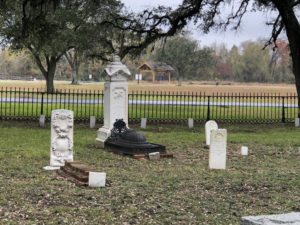 Susan Elizabeth Ryan was Polly’s only surviving child and sole heir of Polly’s estate. She married banker civic leader John Harris Pickens Davis. The Victorian era home sits in a complex that includes a sharecropper’s farm, the family cemetery with graves dating between the 1820s to 1916 and the Oldenberg blacksmith shop. It seemed ironic to me that Polly isn’t in the family cemetery (she’s at Morton Cemetery in Richmond). But the existing monuments are beautiful and well cared for.
Susan Elizabeth Ryan was Polly’s only surviving child and sole heir of Polly’s estate. She married banker civic leader John Harris Pickens Davis. The Victorian era home sits in a complex that includes a sharecropper’s farm, the family cemetery with graves dating between the 1820s to 1916 and the Oldenberg blacksmith shop. It seemed ironic to me that Polly isn’t in the family cemetery (she’s at Morton Cemetery in Richmond). But the existing monuments are beautiful and well cared for. 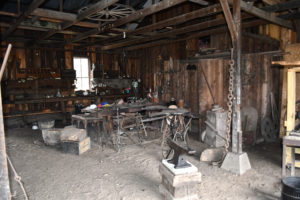
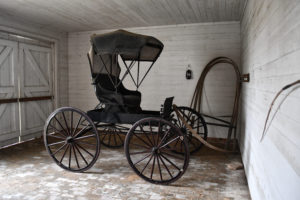 In the blacksmith shop, kids were invited to try their hand at “forging” knives from chunks of clay with rubber mallets.
In the blacksmith shop, kids were invited to try their hand at “forging” knives from chunks of clay with rubber mallets.
In the side yard of the home, a sweet volunteer led visitors in creating Victorian style Christmas ornaments from paper as keepsakes of their visit.
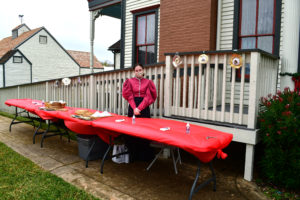
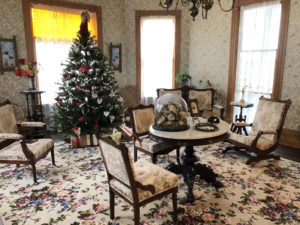
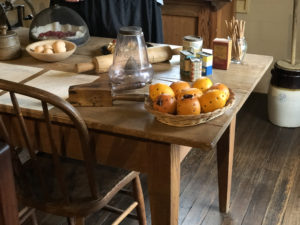
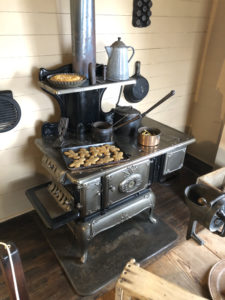

The last home to tour was the 1930s George Ranch House (designed by famous Galveston architect Nicholas Clayton) and complex, where a barbershop quartet was entertaining passersby with Christmas carols.
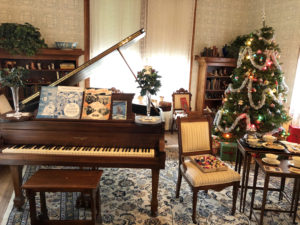
Mamie George and her husband A.P. were the last descendants of the Henry and Nancy Jones family to oversee the ranching operation. Their influence and support is still seen across the community in libraries, schools, the Houston Livestock Show and Rodeo, a community center and countless other contributions. 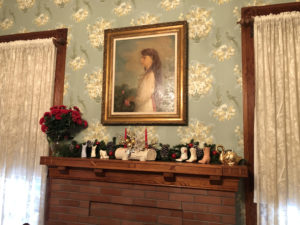
Their home is still decorated with their furnishings, right down to the ornaments on the Christmas tree! I loved Mamie’s collection of ceramic cowboy boots from her travels lined up on the mantle.
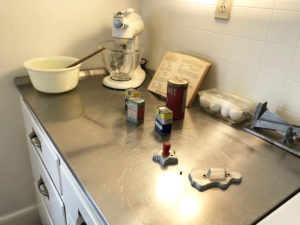
Once all of the home tours were checked off of my list, I headed to the arena and barn area for the cattle working demonstrations.

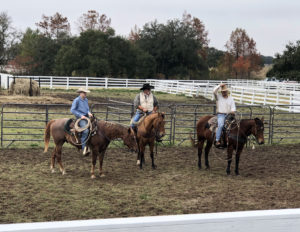
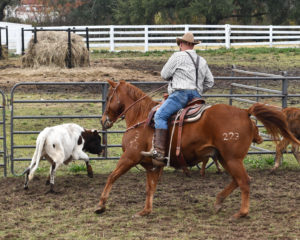
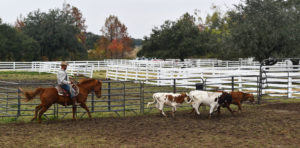
The cowboys demonstrated some basic cutting and lassoing techniques while explaining how and why these things are still down on the working ranch. Afterward, one of the cowboys walked the onlookers over to a dipping vat and related how they were used in the past – and why they aren’t any more (thank heaven!).
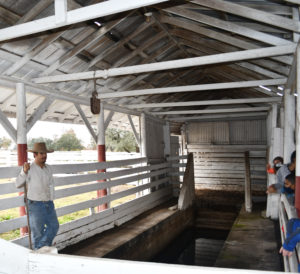
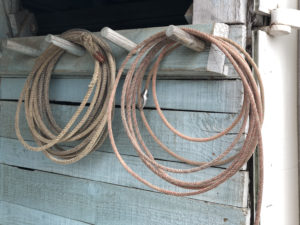
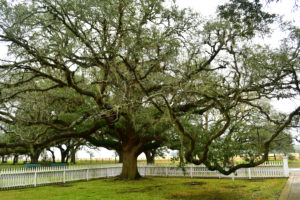

 – one of the earliest settlements of Northeast Mexico. Nope, it wasn’t even Texas yet!
– one of the earliest settlements of Northeast Mexico. Nope, it wasn’t even Texas yet!


 In the nearby hog pen, one of the volunteers scratched the back of one of the docile 300-pound Berkshire pigs that are part of an initiative to preserve heritage breeds. Seems these fragrant residents are descendants of a rare breed that came to Texas from England in the 1830s. I know people who can’t trace their lineage as well!
In the nearby hog pen, one of the volunteers scratched the back of one of the docile 300-pound Berkshire pigs that are part of an initiative to preserve heritage breeds. Seems these fragrant residents are descendants of a rare breed that came to Texas from England in the 1830s. I know people who can’t trace their lineage as well! After a quick look at the chicken coop (always interesting to me since gathering the eggs was my job when visiting my grandmother’s farm), smokehouse barn and outdoor kitchen, I worked my way back to the road to hop on the tram again.
After a quick look at the chicken coop (always interesting to me since gathering the eggs was my job when visiting my grandmother’s farm), smokehouse barn and outdoor kitchen, I worked my way back to the road to hop on the tram again.
 One young woman showed me around the knot garden and chicken coop until it was my turn (social distancing, ya know) to go inside the house.
One young woman showed me around the knot garden and chicken coop until it was my turn (social distancing, ya know) to go inside the house. Susan Elizabeth Ryan was Polly’s only surviving child and sole heir of Polly’s estate. She married banker civic leader John Harris Pickens Davis. The Victorian era home sits in a complex that includes a sharecropper’s farm, the family cemetery with graves dating between the 1820s to 1916 and the Oldenberg blacksmith shop. It seemed ironic to me that Polly isn’t in the family cemetery (she’s at Morton Cemetery in Richmond). But the existing monuments are beautiful and well cared for.
Susan Elizabeth Ryan was Polly’s only surviving child and sole heir of Polly’s estate. She married banker civic leader John Harris Pickens Davis. The Victorian era home sits in a complex that includes a sharecropper’s farm, the family cemetery with graves dating between the 1820s to 1916 and the Oldenberg blacksmith shop. It seemed ironic to me that Polly isn’t in the family cemetery (she’s at Morton Cemetery in Richmond). But the existing monuments are beautiful and well cared for. 
 In the blacksmith shop, kids were invited to try their hand at “forging” knives from chunks of clay with rubber mallets.
In the blacksmith shop, kids were invited to try their hand at “forging” knives from chunks of clay with rubber mallets.




































